Spring cleaning time: Out with the old, in with the new! Last month, I took on the confusion around Old Mexico vs. New Mexico and that put me in the mood for busting another Santa Fe myth. My target is spring green – I’m talking about the Santa Fe landscape in spring and how it defies expectations.
The Piñon Tree Holds Star Status
Locals get a good laugh whenever out-of-state news featuring New Mexico show a stately saguaro cactus towering over the desert landscape…of Arizona! Just like the chronic New Mexico/Mexico mix-up, somehow a story has grown about Santa Fe being a mountain desert. The mountain part is spot-on. At 7,000 feet, that appellation is totally accurate and gorgeous to boot. But the desert part? Just ask the Arizonans who come to Santa Fe for our cool mountain air. The reality is Santa Fe’s is a Piñon-Juniper Woodland! The piñon, our state tree, shares its homeland with the humble and hardy juniper and both thrive with equal tenacity, easily living hundreds of years.
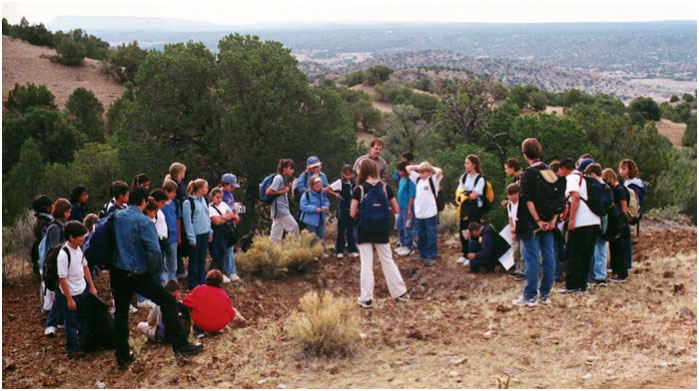 Piñon and juniper offer a dramatic backdrop for a hike at Cerrillos Hills State Park. (Photo credit: Cerrillos Hills State Park)
Piñon and juniper offer a dramatic backdrop for a hike at Cerrillos Hills State Park. (Photo credit: Cerrillos Hills State Park)While healthy piñons and junipers can be spotted on any residential street, a broader view of the natural habitat is warranted. A visit to Cerrillos Hills State Park is a great idea. The low-lying pinon-juniper woodland is readily apparent in Cerrillos Hills, and rangers offer fascinating facts about the flora and fauna. If there’s a budding geologist in your mix, a trip to La Bajada with Outspire Hiking geologist/guide Scott Renbarger gives you a stone-solid grounding in Santa Fe’s ancient landscape.
Santa Fe Corrals Cactus
Santa Fe gardens have plenty of cacti for spring blooming – but that’s from being Southwestern, not from being a desert. Local gardeners love the low level of maintenance required. Drought-tolerant prickly pear and cholla, and those who know their succulent stuff, add New Mexico pincushion or fishhook cacti for variety.
Prickly pear pricks up appetites with jelly made from its paddles, and lucky lookers might spot some at the Santa Fe Farmers’ Market. I love to spice things up with prickly pear green chile jam from the Santa Fe School of Cooking Market (hint: there’s also prickly pear syrup to glaze that Easter ham). And a prickly pear margarita at The Shed or the Amaya Bar at the Hotel Santa Fe makes for a memorable TGIF.
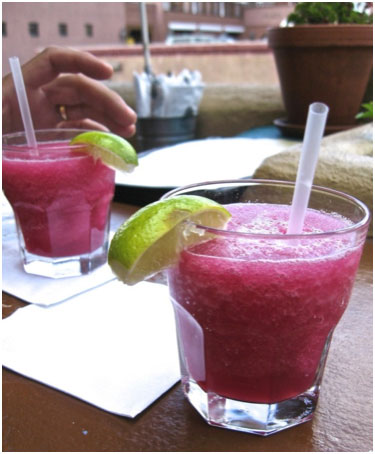 You’ll fee in the pink when the Santa Fe color arrives via a prickly pear margarita. (Photo credit: virutaltourist.com)
You’ll fee in the pink when the Santa Fe color arrives via a prickly pear margarita. (Photo credit: virutaltourist.com)How Does A Santa Fe Garden Grow?
The 2013 opening of the Santa Fe Botanical Garden gave local plant lovers a boost; updating botanic knowledge with the Plant of the Month is a snap. Over fifteen years of patient planning became a 14-acre home for a host of native species that create a picturesque setting for site-specific sculpture exhibits. The Orchard Gardens are now complete, and regular lectures and workshops are a popular way to expand your personal knowledgebase. Phase Two, Ojos y Manos: Eyes and Hands, an educational and cultural center, is plowing its way toward an opening in 2016.
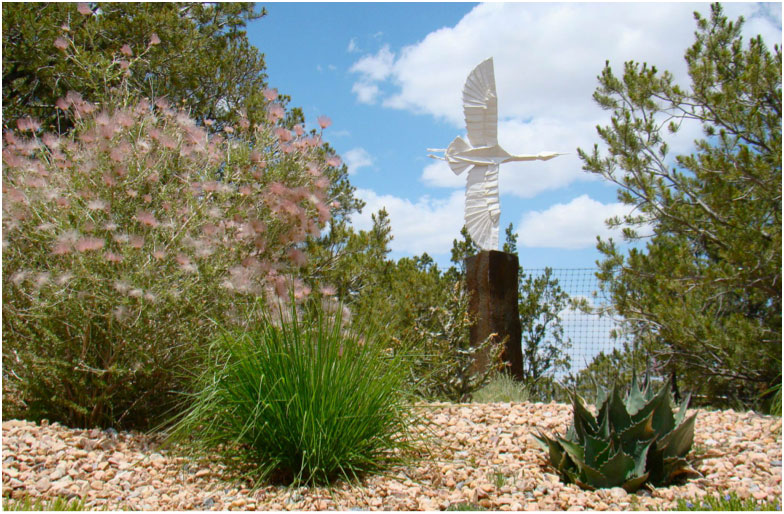
Birds of more than one kind of feather land in the Santa Fe Botanical Garden. (Photo credit: Santa Fe Botanical Garden)
NOT being a desert has growing advantages, evident on a Santa Fe Garden Club Tour. As soon as April flowers start blossoming, the Club begins Pequeno (meaning small in Spanish) Tours. The experience lasts three to four hours and is offered mid-April through October, taking visitors to three stunning residences with gorgeous gardens in the company of a knowledgeable guide. Seeing native plants and exotic species is sure to whet your interest to return for Behind Adobe Walls, a pair of Tuesday tours (July 21 and 28) that visits eight fabulous homes set amidst graceful garden scenery. These tours are a bonus, because the education on beautiful blooms showcases the architectural wonders of Santa Fe style.
Santa Fe Has Hacienda History
Thinking about signature dwellings leads me – literally – to El Rancho de las Golondrinas, one of my favorite places for enjoying New Mexico’s panoramic landscape. With April’s arrival, El Rancho welcomes spring with docent tours (Monday–Friday), perfect for getting the backstory on this historic ranch museum. The events calendar kicks off May 2 and 3 with Battlefields & Homefronts New Mexico: The Civil War and More. Starting in June, self-guided adventures are the modus operandi Wednesday through Sunday; summer to fall, weekends are ripe with cultural experiences that highlight New Mexico’s heritage and the legacy of its hardworking inhabitants.
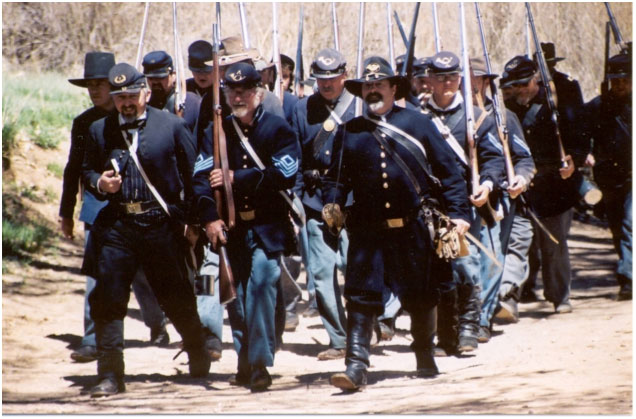
A Civil War weekend at El Rancho de las Golondrinas gives a southwestern slant to the battle of Blue and Gray. (Photo credit: El Ranchi de las Golondrinas)
Legacy brings Leonora Curtin to mind. A nature lover who spent much of her late 1800s childhood in Santa Fe, her book Healing Herbs of the Upper Rio Grande is the result of her fascination with the native herbs plied by curanderas, natural healers who doctored rural New Mexico villagers. The Leonora Curtin Wetland, a pristine 35-acre preserve named for this avid naturalist lies adjacent to El Rancho de las Golondrinas, which Curtin purchased with her mother in 1932. Open May to October on Saturdays from 9:00 a.m. to noon and Sundays from 1:00 to 4:00 p.m., the preserve offers free guided walks by Botanical Garden docents on the first and third Saturday. Located in a rare natural cienega (the Spanish word for marsh), the wetland boasts three distinct plant zones well worth examining.
Climate + Countryside = The City Different
I’ve made my case for closer examination of Santa Fe’s nature. Desert, no; dry, yes – a real plus since our low humidity makes the City Different utterly delightful whether temperatures go high or low. Ideal weather is definitely part of our appeal, and so is the lack of biting insects that can’t survive our altitude. I can promise you this: When your Santa Fe getaway reveals the climate-created color in our piñon-juniper woodland, you’ll never think of Santa Fe as home to saguaros again!
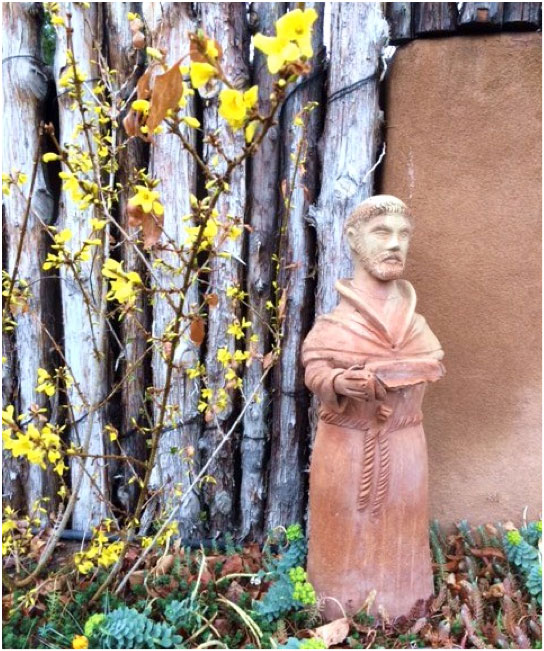 St. Francis, Santa Fe’s patron saint, knows that spring is a harbinger of Santa Fe’s Summer of Color.
St. Francis, Santa Fe’s patron saint, knows that spring is a harbinger of Santa Fe’s Summer of Color.








